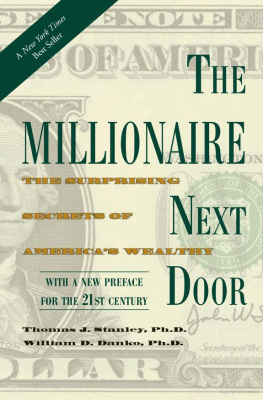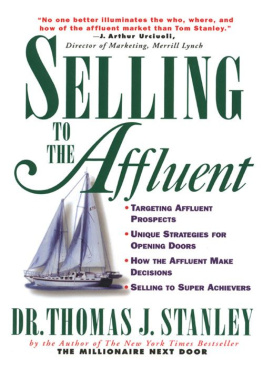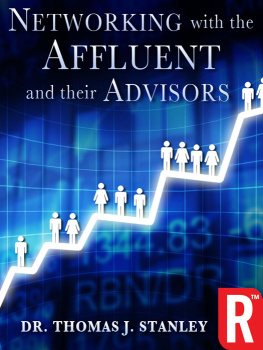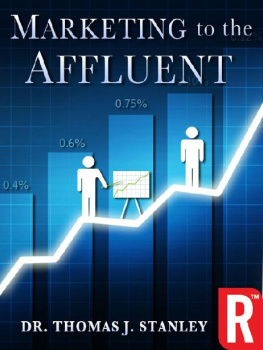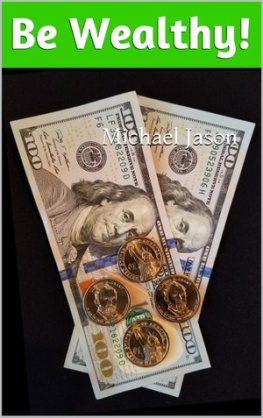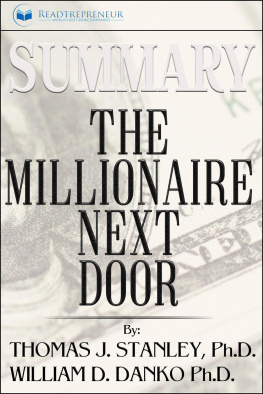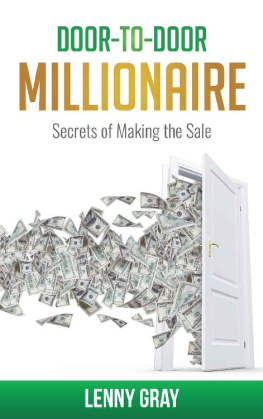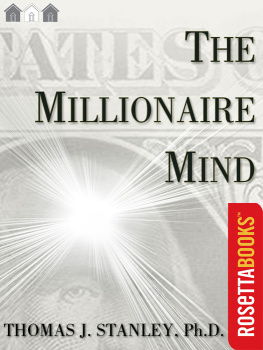Thomas J. Stanley, Ph.D.
William D. Danko, Ph.D.
Copyright
The Millionaire Next Door
Copyright 1996 by Thomas J. Stanley and William D. Danko
Preface copyright 2010 by Thomas J. Stanley
Cover art to the electronic edition copyright 2010 by RosettaBooks, LLC
All rights reserved, including the right to reproduce this book or portions there of in any form whatsoever.
This publication is designed to provide accurate and authoritative information in regard to the subject matter covered. It is sold with the understanding that neither the author nor the publisher is engaged in rendering legal, investment, accounting, or other professional services. If legal advice or other expert assistance is required, the services of a competent professional person should be sought.
All the names in the case studies contained in this book are pseudonyms.
Electronic edition published 2010 by RosettaBooks LLC, New York.
ISBN Mobipocket edition: 9780795314858
For Janet, Sarah, and Brada million Christmases,
a trillion Fourth of Julys
T. J. Stanley
For my loving wife, Connie, and my dear children,
Christy, Todd, and David
W. D. Danko
Contents
Tables
This publication is designed to provide accurate and authoritative information in regard to the subject matter covered. It is sold with the understanding that neither the author nor the publisher is engaged in rendering legal, investment, accounting, or other professional services. If legal advice or other expert assistance is required, the services of a competent professional person should be sought.
All the names in the case studies contained in this book are pseudonyms.

A reporter recently asked me about the changes I have noticed among the American millionaire population since the current economic meltdown. She wanted to know if the millionaire market is dead given the recent reversals in the market value of stocks and homes. I replied that the millionaire next door is still alive and kicking even today in this recession. Since 1980 I have consistently found that most millionaires do not have all of their wealth tied up in their stock portfolios or in their homes. One of the reasons that millionaires are economically successful is that they think differently. Many a millionaire has told me that true diversity has much to do with controlling ones investments; no one can control the stock market. But you can, for example, control your own business, private investments, and money you lend to private parties. Not at any time during the past thirty years have I found that the typical millionaire had more than 30 percent of his wealth invested in publicly traded stocks. More often it is in the low-to-mid-20-percent range. These percentages are consistent with those found in studies conducted by the Internal Revenue Service, which has the best data set on millionaires in the world.
Consider the profile of a millionaire-next-door-type couple, Ms. T and her husband. To most, this couples lifestyle is boring, even common. This millionaires brand of watch is a Timex; her husbands is a Seiko (number one among millionaires). The couple buys their clothes at Dillards, J.C. Penney, and TJ Maxx. They have purchased only two motor vehicles in the past 10 years: both Fords. The current market value of their home is approximately $275,000. Ms. Ts most recent haircut cost $18. Yet they are uncommon in the sense that they are financially independent.
When I speak of people like Ms. T and her husband, invariably someone will ask: But are they happy? Fully 90 percent of millionaires who live in homes valued at under $300,000 are extremely satisfied with life. And, in my most recent work, I state that there are nearly three times as many households with investments of $1 million or more living in homes valued at $300,000 or less than there are living in homes valued at $1 million or more.
Even most multimillionaires in America dont live in expensive homes. I recently tabulated the 2007 IRS estate data (the latest data available) for those decedents with an estate valued at $3.5 million or more. I estimated that the median market value of a decedents home was $469,021, or less than 10 percent of their median net worth. On average these decedents had more than two-and-one-half times more of their wealth invested in investment real estate than in their own personal homes.
Profiling the millionaire next door population was a cumulative process which continues today. Originally I used a different description to define this segment. I first coined the wealthy blue collar segment in a paper entitled Market Segmentation: Utilizing Investment Determinants, which I presented on October 10, 1979 at a conference of the Securities Industry Association in New York City. The paper was later published by the American Marketing Association. Earlier in May 1979, the New York Stock Exchange had asked me to develop a set of marketing implications and recommendations based upon its then recently completed national survey of 2,741 households on investment patterns and attitudes and behaviors about money. This provided a base for the above-mentioned paper. A key point I made in this paper was:
opportunities exist in segments that the [investment] industry has ignored for years. [Members of] the really big segment, the wealthy blue collar, do not need to purchase expensive artifacts that are part of the white collar workers knapsack.
At the time of my presentation I realized that the blue-collar/millionaire next door segment did exist, and it was likely to be a sizable one. Not long after I first idenrified this marker, I discovered how very large it indeed was.
In June 1980 I was asked by a large money center bank to conduct a national study of the millionaire population in America. During the planning stage, an event took place which had a major influence upon the direction of my career I encountered my epiphany about the millionaire-next-door segment one morning at a task force meeting with my client and a colleague and friend, Jon Robbin. Jon is a Harvard-trained mathematician who profiled the wealth characteristics of the residents within each of more than 200,000 neighborhoods across America. He said, in passing, About one-half of the millionaires in America dont live in upscale neighborhoods. Thats when the light went on inside my head! The really compelling story was not the millionaire population in general. Rather it was the low-profile millionaires, the ones who lived in modest homes situated in middle-class, even working-class neighborhoods. From that moment on, I intensely began studying and writing about the millionaire-next-door types. The research that I conducted thirty years ago in 1980 was the first comprehensive national study about the size, geographic distribution, and financial lifestyles of millionaires. The key findings were highly congruent with the numerous studies that I have conducted since that time.
I authored The National Affluent Study 1981-1982 for a consortium of the top fifty financial institutions in America. In addition to designing this study, I traveled the country conducting focus group interviews with millionaires. Later, many of these financial institutions, including seven of the top ten trust companies in America, asked me to conduct focus group interviews and surveys of the affluent on their behalf. As a result, I had the opportunity to meet with more than 500 millionaires face to face. My interpretation of these interviews as well as many others that I conducted is given throughout The Millionaire Next Door. Interestingly, the millionaires I interviewed in Oklahoma and Texas, for example, had the same set of traditional American values as those whom I interviewed in New York City and Chicago. The large majority was keenly interested in being financially independent. Thats why they lived below their means.

